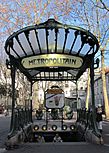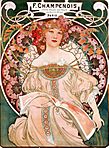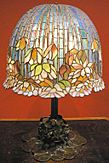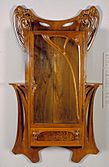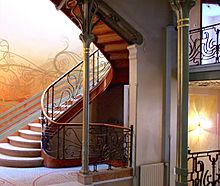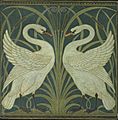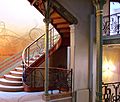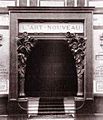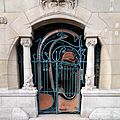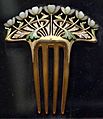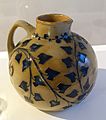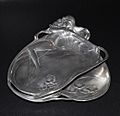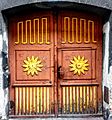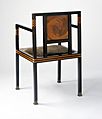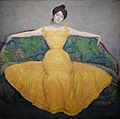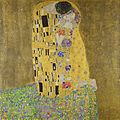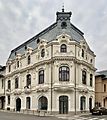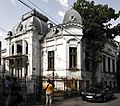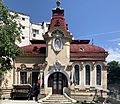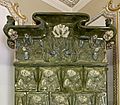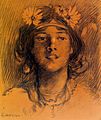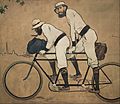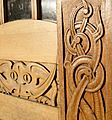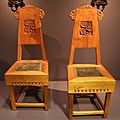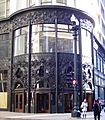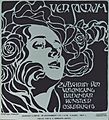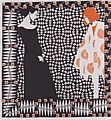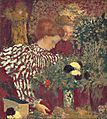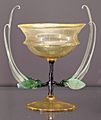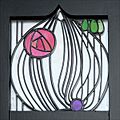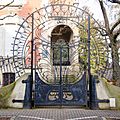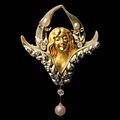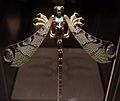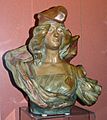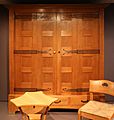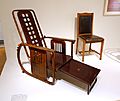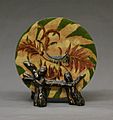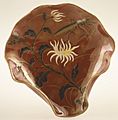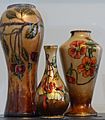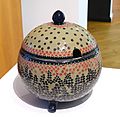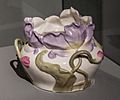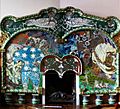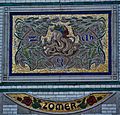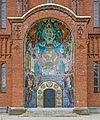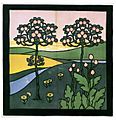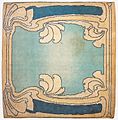Art Nouveau facts for kids
|
Paris metro station Abbesses, by Hector Guimard (1900); Lithograph by Alphonse Mucha (1897); Lamp by Louis Comfort Tiffany (1900–1910); Wall cabinet by Louis Majorelle; Interior of Hôtel Tassel by Victor Horta (1894)
|
|
| Years active | 1890–1910 |
|---|---|
| Country | International |
Art Nouveau was a popular art style that appeared around the late 1800s. It was an international movement, meaning it was popular in many countries. This style focused on organic shapes, like those found in nature.
You could see Art Nouveau in many places. It was used in modern art, graphic design (like posters), and architecture (buildings). It also appeared in everyday items. These included decorations, jewellery, ceramics (pottery), and glass objects.
Art Nouveau was most popular between 1890 and 1905. It continued to be used until the First World War.
Contents
What is Art Nouveau?
Art Nouveau was a new way of designing things. It was a reaction to the older, more traditional art styles of the 1800s. The style is very natural and flowing.
It often uses shapes inspired by flowers and plants. You'll see curvy lines that look like vines or waves. A main idea of Art Nouveau was that artists should design everything. From buildings to furniture, art should be part of daily life.
How did Art Nouveau start?
A Czech artist named Alphonse Mucha greatly influenced this art movement. Mucha created a lithographed poster in 1895. It was an advertisement for a play called Gismonda. The famous actress Sarah Bernhardt starred in it.
This poster appeared on the streets of Paris on January 1, 1895. People loved it right away! It showed off a brand new art style and the artist who made it. At first, people called it the Style Mucha. But soon, it became known as Art Nouveau.
Where was Art Nouveau popular?
Art Nouveau lasted about fifteen years. It was very popular across Europe. You could find it from Glasgow to Moscow and Madrid. But its influence spread even further, all around the world.
In France, Hector Guimard designed the famous entrances for the Paris Metro. These designs really changed how Paris looked. Also, Emile Gallé was a key artist in the city of Nancy. In Belgium, Victor Horta had a huge impact on how buildings were designed.
Magazines like Jugend helped spread the style in Germany. It was especially popular there for graphic design. The Vienna Secession artists also influenced art and buildings in Austria-Hungary.
Many famous artists were part of Art Nouveau. They included Gustav Klimt, Charles Rennie Mackintosh, Alphonse Mucha, René Lalique, Antoni Gaudí, and Louis Comfort Tiffany. Each of these artists used the style in their own unique way.
Why is Art Nouveau important today?
Art Nouveau became less popular when new modernist styles appeared in the 20th century. But today, it is seen as a very important link. It connects older styles like Neoclassicism with modern art.
Many Art Nouveau buildings are now recognized by UNESCO. They are on the World Heritage Sites list. This means they are important parts of our cultural history.
For example, the historic center of Riga, Latvia, is on the list. It has "the finest collection of art nouveau buildings in Europe." Four town houses in Brussels by Victor Horta were also added. They are seen as amazing examples of Art Nouveau architecture. They show how art and society changed from the 19th to the 20th century.
Images for kids
-
The Red House by William Morris and Philip Webb (1859)
-
Japanese woodblock print by Utagawa Kunisada (1850s)
-
The Peacock Room by James McNeill Whistler (1876–1877)
-
William Morris printed textile design (1883)
-
Swan, rush and iris wallpaper design by Walter Crane (1883)
-
Chair designed by Arthur Mackmurdo (1882-1883)
-
Hankar House by Paul Hankar (1893)
-
Facade of the Hôtel Tassel by Victor Horta (1892–1893)
-
Bloemenwerf house by Henry van de Velde (1895)
-
Gateway of the Castel Béranger by Hector Guimard (1895–1898)
-
Main entrance to the Paris 1900 Exposition Universelle
-
Entrance to the Austrian Pavilion, with exhibits designed by Josef Hoffmann
-
Paris metro station entrance at Abbesses designed by Hector Guimard for the 1900 Exposition universelle
-
Armas Lindgren and Eliel Saarinen won international recognition for their design of the pavilion of Finland
-
Menu designed by Alfons Mucha for the restaurant of the Bosnia Pavilion
-
Poster for the dancer Loie Fuller by Jules Chéret (1893)
-
Poster by Alfons Mucha for Gismonda starring Sarah Bernhardt (1894)
-
The jewellery shop of Georges Fouquet at 6, rue Royale, Paris, designed by Alphonse Mucha, now in the Carnavalet Museum (1901)
-
Comb of horn, gold, and diamonds by René Lalique (c. 1902) (Musée d'Orsay)
-
The Villa Majorelle in Nancy for furniture designer Louis Majorelle by architect Henri Sauvage (1901–02)
-
The Hôtel van Eetvelde by Victor Horta, Brussels (1898–1900)
-
Former Old England department store by Paul Saintenoy, Brussels (1898–1899)
-
Chair by Henry van de Velde (1896)
-
Bed and mirror by Gustave Serrurier-Bovy (1898–1899), now in the Musée d'Orsay, Paris
-
Philippe Wolfers, Plume de Paon, (Collection King Baudouin Foundation, depot: KMKG-MRAH)
-
Cover design by Arthur Mackmurdo for a book on Christopher Wren (1883)
-
Willow Tearooms by Charles Rennie Mackintosh, 217 Sauchiehall Street, Glasgow (1903)
-
Belt buckle by Archibald Knox for Liberty Department Store
-
Embroidered panels by Margaret Macdonald Mackintosh (1902)
-
Jugendstil dining room set and dishes by Peter Behrens (1900–1901)
-
Ernst Ludwig House by Joseph Maria Olbrich (1900) now hosting Darmstadt Colony Museum
-
The Secession Hall in Vienna by Joseph Maria Olbrich (1897–98)
-
Armchair by Koloman Moser (c. 1900)
-
The Kiss by Gustav Klimt (1907–08)
-
Floral design by Alois Ludwig on the facade of Maiolica House by Otto Wagner (1898)
-
Karlsplatz Stadtbahn Station by Otto Wagner (1899)
-
Interior of the Kirche am Steinhof by Otto Wagner (1904–1907)
-
The Palais Stoclet in Brussels by Josef Hoffmann (1905–1911)
-
Museum of Applied Arts in Budapest by Ödön Lechner (1893–1896)
-
Geological Museum of Budapest by Ödön Lechner (1898–1899)
-
Gróf Palace in Szeged by Ferenc Raichle (1913)
-
Mosaic by Miksa Róth at Török Bank building in Budapest (1906)
-
Relief at the facade of Gresham Palace by Géza Maróti in Budapest (1906)
-
Frescoes of Municipal House in Prague by Alphonse Mucha
-
The center of a stove from a city-house in the Rosetti Square area (Bucharest)
-
Relief on the façade of a small block, close to the Colțea Hospital, Bucharest
-
House on Dimitrie Racoviță Street, Bucharest
-
The Dianu House from Craiova (1900-1905)
-
The top of a tiled stove from the George Severeanu Museum, Bucharest
-
Frescos on the ceiling of the Antim Monastery Church's portico, Bucharest
-
Decorative panel by Ștefan Luchian (1900)
-
Palazzo Castiglioni in Milan by Giuseppe Sommaruga (1901–1903)
-
Carlo Bugatti, Cobra Chair and Desk (1902), Brooklyn Museum
-
Sagrada Família basilica in Barcelona by Antoni Gaudí (1883–)
-
Trencadís facade of Casa Batlló by Antoni Gaudí and Josep Maria Jujol (1904–06)
-
Casa Milà by Antoni Gaudí (1906–1912)
-
Hospital de Sant Pau by Lluis Domenech i Montaner (1901–30)
-
Casa de les Punxes by Josep Puig i Cadafalch (1905)
-
Sanctuary of Maria Magdalena in Novelda, Valencian Community
-
Lowboy by Antoni Gaudí (1889)
-
Stained glass ceiling of Palau de la Música Catalana by Antoni Rigalt (1905–1908)
-
Facade of Major Pessoa Residence in Aveiro (1907–1909)
-
Museum-Residence Dr. Anastácio Gonçalves in Lisbon (1904–1905)
-
The Livraria Lello bookstore in Porto, Portugal (1906)
-
Details of Almirante Reis, 2-2K building in Lisbon (1908)
-
Ceramic tile of Cooperativa Agrícola in Aveiro (1913)
-
Chair by Eliel Saarinen (1907–1908)
-
Art Nouveau Centre in Ålesund (1905–1907)
-
Cup and saucer from the 'iris' service (1897), in the Los Angeles County Museum of Art
-
Altar of Engelbrektskyrkan in Stockholm (1914)
-
Poster for the Baltic Exhibition in Malmö (1914)
-
An Art Nouveau Fabergé egg (1898)
-
Illustration of the Firebird by Ivan Bilibin (1899)
-
Set for Nikolai Rimsky-Korsakov's ballet Scheherazade by Léon Bakst (1910)
-
Program design for "Afternoon of a Faun" by Léon Bakst for Ballets Russes, (1912)
-
Ceramic fireplace on Russian folklore theme by Mikhail Vrubel (1908)
-
Facade of the Hotel Metropol in Moscow with mosaics by Mikhail Vrubel (1899–1907)
-
Dining room of the Grand Hotel Europe in Saint Petersburg (1910)
-
Villa Fallet with fir-inspired decoration (1906) by Le Corbusier (1905)
-
Tiffany Chapel from the 1893 Word's Columbian Exposition, now in the Charles Hosmer Morse Museum of American Art in Winter Park, Florida
-
Glass vase by Louis Comfort Tiffany now in the Cincinnati Art Museum (1893–96)
-
Poster Century by Louis John Rhead (1894)
-
Wisteria lamp by Louis Comfort Tiffany (circa 1902), in the Virginia Museum of Fine Arts
-
Windows of the Wainwright Building by Louis Sullivan (1891)
-
South State Street entrance to the Carson, Pirie, Scott and Company Store (1899) by Louis Sullivan
-
Detail of the Prudential (Guaranty) Building, New York Louis Sullivan (1896)
-
National Farmer's Bank of Owatonna by Louis Sullivan (1907–08)
-
Stained glass and sculptures by Ercole Pasina in Calise House in Buenos Aires (1911)
-
Interior of Galería Güemes, Buenos Aires by Francisco Gianotti (1913)
-
Palacio Barolo in Buenos Aires by Mario Palanti (1919-1923)
-
Metal work, ceramics and statues at the facade of Club Español building in Rosario (1912)
-
Floor of the Hôtel Tassel, by Victor Horta, with a whiplash vegetal motif (1893)
-
Coup de Fouet or whiplash motif, depicting the stems of cyclamen flowers, by Hermann Obrist (1895)
-
Stylized vegetal forms; Entrance of the Anvers Metro Station in Paris by Hector Guimard (1900)
-
Floral patterns. Lamp with Wisteria design by Louis Comfort Tiffany (1899-1900)
-
Highly stylized floral designs in balconies and railings. Otto Wagner stairway in Majolica House, Vienna (1898)
-
Geometric lines the Vienna Secession; Palais Stoclet by Josef Hoffmann (1905–1911)
-
The Peacock Skirt, by Aubrey Beardsley, (1892)
-
Poster for Grafton Galleries by Eugène Grasset (1893)
-
Divan Japonais lithograph by Henri de Toulouse-Lautrec (1892–93)
-
Biscuits Lefèvre-Utile by Alphonse Mucha (1896)
-
Cover for the Book of Common Prayer, vellucent binding by Cedric Chivers (1900s)
-
Ver Sacrum illustration by Koloman Moser (1899)
-
Le Corsage rayé by Édouard Vuillard (1895), National Gallery of Art
-
Paul Sérusier, Women at the Spring, Musée d'Orsay (1898)
-
Watercolour and ink painting of Loïe Fuller Dancing, by Koloman Moser (1902)
-
Slavia by Alphonse Mucha (1908)
-
Detail of the frieze by Gustav Klimt in the Palais Stoclet, Brussels (1905–1911)
-
Cup Par une telle nuit by Émile Gallé, France, (1894)
-
Lampe aux ombelles by Émile Gallé, France, (about 1902)
-
Rose de France cup by Émile Gallé, (1901)
-
Daum vase, France, (1900)
-
Lamp by Daum, France (1900)
-
Henri de Toulouse-Lautrec, Louis Comfort Tiffany, Au Nouveau Cirque, Papa Chrysanthème, c.1894, stained glass, Musée d'Orsay
-
Stained glass window Veranda de la Salle by Jacques Grüber in Nancy, France (1904)
-
Window for the House of an Art Lover, by Margaret Macdonald Mackintosh (1901)
-
Lily lamp by Louis Comfort Tiffany (1900–1910)
-
Iridescent vase by Louis Comfort Tiffany (1904)
-
Stained glass window Architecture by John La Farge U.S. (1903)
-
Stained glass windows by Koloman Moser for the Church of St. Leopold, Vienna (1902–07)
-
Balcony of Castel Béranger in Paris, by Hector Guimard (1897–98)
-
Railings by Louis Majorelle for the Bank Renauld in Nancy
-
Table Lamp by François-Raoul Larche in gilt bronze, with the dancer Loïe Fuller as model (1901)
-
Light fixture by Victor Horta (1903)
-
Cast iron Baluster by George Grant Elmslie (1899-1904)
-
Lamp by Ernst Riegel made of silver and malachite (1905)
-
Gate of the Palais Stoclet by Josef Hoffmann, Brussels (1905-1911)
-
A corsage ornament by Louis Tiffany (1900)
-
Dragonfly Lady brooch by René Lalique, made of gold, enamel, chrysoprase, moonstone, and diamonds (1897–98)
-
Necklace by Charles Robert Ashbee (1901)
-
Philippe Wolfers, Niké Brooch (1902), collection King Baudouin Foundation, depot: KMKG-MRAH
-
Entrance of Hôtel Solvay in Brussels by Victor Horta (1898)
-
Detail of the facade of the Villa Majorelle by Henri Sauvage in Nancy (1901–02)
-
Whiplash motifs at Vitebsky railway station by Sima Mihash and Stanislav Brzozowski, Saint Petersburg (1904)
-
One of the mascarons made by Adamo Boari in the facade of the Palacio de Bellas Artes in Mexico City, Mexico (1904–1934)
-
Asymmetric facade with curved lines of De Beck building by Gustave Strauven in Brussels (1905)
-
Irises and mascaron at the facade of Schichtel building by Aloys Walter in Strasbourg, France (1905–06)
-
Spiral staircase in Maison and Atelier Horta by Victor Horta in Brussels (1898–1901)
-
Detail of Stoclet Palace in Brussels (1905–1911)
-
Interior of Palau de la Música Catalana in Barcelona (1905–1909)
-
Entrance buildings in Parc Güell by Antoni Gaudí in Barcelona (1900–1914)
-
Statue of polychrome terracotta by Lambert Escaler in Barcelona (1901)
-
High-relief of swans and statues in the interior of Aarhus Theatre by Karl Hansen Reistrup in Aarhus, Denmark (1897–1900)
-
High-relief of owls in Katajanokka by Georg Wasastjerna, Helsinki (1903)
-
Sculpture by Ernest Bussière in Nancy, France
-
Bear statue by Emil Wikström at National Museum of Finland (1905–1910)
-
Bas-relief in Sprudelhof by Heinrich Jobst in Bad Nauheim, Germany (1905–1911)
-
Monument to Siege of Zaragoza by Agustí Querol Subirats (1908)
-
Atlantes, caryatids at Sankt-Mang-Brunnen by Georg Wrba in Kempten, Germany (1905)
-
Ceramic putti in Music conservatory of Barcelona by Eusebi Arnau (1916–28)
-
Chair by Henry van de Velde, Belgium (1896)
-
Chair by Charles Rennie Mackintosh, UK (1897–1900)
-
Stool by Paul Hankar, Belgium (1898)
-
Furniture set by Victor Horta in the Hôtel Aubeque from Brussels (1902–1904)
-
"Dawn and Dusk" bed by Émile Gallé, France (1904)
-
Adjustable armchair Model 670 "Sitting Machine" designed by Josef Hoffmann, Austria (1904–1906)
-
Victor Horta, furniture from Turin (1902), in the collection of the King Baudouin Foundation.
-
Glazed earthenware vase by Émile Gallé(1880–1885) (Metropolitan Museum)
-
Earthenware plate and sculpted stand (1884) by Émile Gallé (Metropolitan Museum)
-
Faience or earthenware vase with two feet, with mountain night scene on the back and a floral daylight scene with butterfly on the front, by Émile Gallé (1884–1885)
-
Amphora with elm-leaf and blackberry manufactured by Stellmacher & Kessner
-
Rookwood Pottery Company vase of ceramic overlaid with silver by Kataro Shirayamadani, U.S., (1892)
-
Rookwood Pottery Company vase by Carl Schmidt (1904)
-
Zsolnay factory and Miksa Róth mosaics of Schmidl Mausoleum in Budapest (1902–03)
-
Tile of Cooperativa Agrícola in Aveiro (1913)
-
Majolica House in Vienna by Otto Wagner (1898)
-
Majolica fireplace, house of Bazhanov, Abramtsevo Colony, by Mikhail Vrubel (1898)
-
Mandylion by Nicholas Roerich in Talashkino, Russia (1908–1914)
-
Mosaics for Palace of Culture by Aladár Körösfői-Kriesch and Miksa Róth in Târgu Mureș, Romania (1911–1913)
-
Trencadís mosaics in Park Güell by Antoni Gaudí in Barcelona (1914)
-
Tile of Cooperativa Agrícola in Aveiro (1913)
-
Maiolica mural of Abramtsevo Colony in Russia (1870s–1890s)
-
Mosaics by Louis Comfort Tiffany (1915)
-
Page on the Water Lily, from the book by Eugène Grasset on ornamental uses of flowers (1899)
-
Textile design by Koloman Moser (1899)
-
Victor Horta, A carpet in the collection King Baudouin Foundation.
See also
 In Spanish: Modernismo (arte) para niños
In Spanish: Modernismo (arte) para niños


